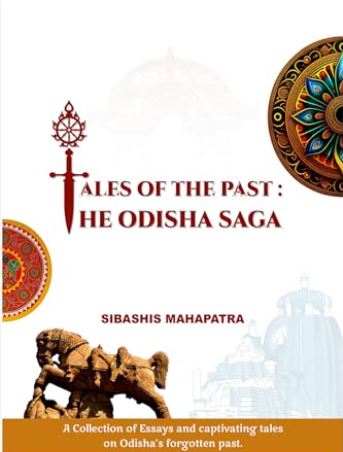Aditya Raj Sinha reviews Sibashis Mahapatra's book on Odia history.
“Tales of The Past: The Odisha Saga” by Shibashis Mahapatra – A Review

In the scholarly landscape where the confluence of engineering acumen and historical inquiry seldom occurs, Sibashis Mahapatra’s “Tales of The Past: The Odisha Saga” emerges as a fresh spot that attempts to bridge this divide with remarkable finesse.
Shibashis, despite his primary background in engineering, has ventured into the historiographical domain to offer a compelling narrative of Odia history, encapsulated through a series of essays that navigate the reader through the multifaceted epochs of Kalinga.
At the heart of Mahapatra’s compendium of essays and other brief works is a meticulous assembly of historical research that illuminates the often complex political, social, and cultural developments of the Kalingan dynasties. The author skillfully navigates the intergenerational narratives, alliances, and feuds that have shaped the region, employing a lucid writing style that maintains academic rigour without sacrificing engagement. This balance is particularly evident in the opening chapter itself, which sets the stage for the Odia struggle against various adversaries, effectively encapsulating the resilience and tenacity of the Kalingan spirit across different historical periods.
Mahapatra’s work is distinguished by its comprehensive analysis of Odia history, articulated through eleven essays that collectively offer a panoramic view of the region’s past. Each essay serves as a lens through which the reader gains insights into the origins, expansion, and eventual transformations of Odia culture, arts, traditions, and their intricate relationships with the political dynamics of the time. The author’s ability to distill complex historical phenomena into coherent narratives is commendable, making the book an invaluable resource for both scholars and lay readers interested in the rich tapestry of Odia heritage.
A standout feature of Mahapatra’s narrative technique is the vivid recreation of key historical moments, such as the rise and fall of Devavarman Rajaraja and the construction of the grand Jagannath Temple. The amoral nature of medieval Indian politics and war is also captured in the episodes of Kalinga’s conflicts with its hostile neighbourhood, from Cholas to Vijayanagar kings, and the line of Maratha generals in the late 18th century.
Although the book is full of cultural revitalization associated with native political ascendency, Shibashis does a decent job of drawing the line between it and the destruction caused by other Hindu powers in Odisha, such as Marathas. These accounts are not merely historical reconstructions but are imbued with a sense of immediacy and vividness that transports the reader to the heart of Kalingan history.
As the uninitiated reader may soon find themselves burdened with too much information, there are well-placed cues and chapters written on trivia, culture, and travel to cool off the heat of the historical trails. However, the density of the chapters could be toned down a little for general readers new to the subject.
Furthermore, the inclusion of a fictional recreation of a historical period towards the book’s conclusion serves as a creative stratagem that not only humanizes historical figures but also renders the historical narrative more relatable and engaging to the reader. This approach underscores Mahapatra’s innovation in historical storytelling, merging factual rigour with imaginative reenactment.
Sibashis Mahapatra’s “Tales of The Past: The Odisha Saga” is more than a mere historical account; it is a significant contribution to the scholarship of Odia history. The author’s interdisciplinary approach, leveraging his engineering background to bring a fresh perspective to historical analysis, enriches the academic discourse surrounding the region’s past. Mahapatra’s work is a testament to the potential of interdisciplinary scholarship in offering new insights and understandings of historical narratives.
In conclusion, Sibashis Mahapatra’s foray into the annals of Odia history has culminated in a work that is narratively engaging. “Tales of The Past: The Odisha Saga” stands as a crucial addition to the corpus of historical literature on Odisha, offering scholars and enthusiasts alike a comprehensive and vivid portrayal of the region’s historical landscape.
Published by Notionpress, the book is available in both paperback and digital editions on Amazon, making it accessible to a broad audience keen on exploring the depths of Odia history.

Leave a Reply